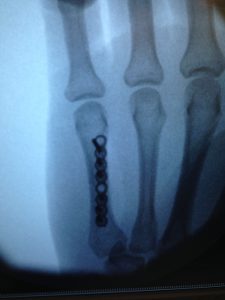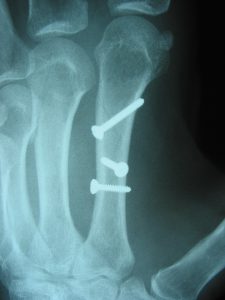Fractures of the metacarpal bones
What is it?
A fracture is any kind of break in the bone. The metacarpal bones are long cylindrical bones in the hand that sit between the carpus (wrist) and the fingers.
Who gets it and what causes it?
Metacarpal fractures are very common injuries following a fall on the hand, trapping of the hand or after a punching or boxing injury.
Fracture of the 5th (little finger) metacarpal often occurs after landing a punch and can be referred to as a ‘Boxer’s fracture’.
What are the signs and symptoms?
Patients may experience pain, swelling and bruising in the hand. There maybe difficulty making a fist. On examining the hand there may be rotation of the affected finger, which may result in difficulty making a full fist.
What tests will I need?
The first step is to undergo a consultation, involving a medical history and clinical examination. Mr Naqui may organise further tests such as an x-ray or MRI scan. X-rays help to identify the pattern of any metacarpal fracture(s). MRI scans can help visualise any associated ligament injury, which is usually uncommon and not required.


What is the treatment?
Treatment will depend on the type of fracture. The goal of treatment is to give you a hand that can perform its daily functional activities and grip well without pain or stiffness.
Fractures which have little displacement or rotation are usually treated conservatively by a splint. Regular x-rays will help monitor the progress over the course of a 4 to 6 week period. There is generally a good prognosis with restoration of normal function.
Rotated and displaced fractures, multiple metacarpal fractures or fractures which involve the joints may require surgery. This is followed by hand therapy to regain and maintain good finger function and grip.
What does the surgical treatment involve?
Surgery may be performed under regional or general anaesthetic and is generally a day case procedure meaning that you will be able to go home the same day.
The fracture pattern will dictate the surgical method. Methods include fracture manipulation (turning or changing the position of the fractured bone) and splint immobilisation, the addition of small wires for a temporary period or opening the fracture and using a small plate and screws. Each method has its special indications, its advantages and disadvantages. Mr Naqui will go through these options with you in detail before agreeing a course of action.

What happens after the surgery?
Taking simple painkillers such as paracetamol regularly for the first 2 days after the operation will help to relieve any post-operative pain.
The hand will be placed in a cast following the surgery for around 4 weeks. There may be no cast if the bone has been fixed with a plate. Any sutures inserted will be removed at 10 days after surgery.
Mr. Naqui and the hand therapist will then provide you with specific exercises to perform to regain normal movements of the hand.
When I can return to normal activity?
Fractures take around 6 weeks to heal on average. Bones in the hand can heal faster. Contact sports should be avoided for 3 months. Mr. Naqui will discuss with you regarding return to sports depending upon your particular sport as splints could be worn to get you back quicker. Driving can safely be resumed at around 6 weeks. Return to work is dependent on the nature of you work but usually expected within 2 weeks if it is non-manual work. You can discuss this with Mr Naqui at your consultation.
What are the complications of surgery?
The main potential complications that will be discussed with your prior to gaining consent for surgery include pain, swelling, infection, stiffness, scarring, numbness and occasionally non-union (non healing of the fracture). Pain and swelling are common following surgery, these should settle after a few days with simple painkillers. Infection is rare. Stiffness at the joint should resolve if you follow the exercise programme as advised by Mr Naqui and the hand therapist following surgery. Injury to nerves around the hand may occur during surgery and lead to a feeling of numbness. In a small proportion of patients healing of the fracture does not occur. If this were to happen then there are further surgical options, which you can discuss with Mr Naqui.





